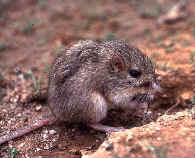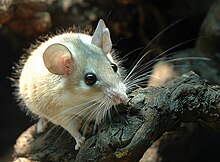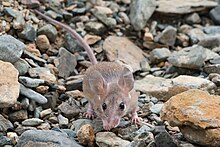
The subfamily Deomyinae consists of four genera of mouse-like rodents that were previously placed in the subfamilies Murinae and Dendromurinae. They are sometimes called the Acomyinae, particularly in references that antedate the discovery that the link rat, Deomys ferugineus, is part of the clade. Deomyinae is the older name and therefore has priority over Acomyinae.

The term spiny mouse refers to any species of rodent within the genus Acomys. Similar in appearance to mice of the genus Mus, spiny mice are small mammals with bare tails which contain osteoderms, a rare feature in mammals. Their coats are endowed with unusually stiff guard hairs similar to the spines of a hedgehog; this trait is the source of the common name, spiny mouse.

The golden spiny mouse gets its name from the reddish-orange spiny fur that covers its body from head to tail. This coarse, inflexible fur is thought to protect it from predation. Aside from the golden fur that covers its head and upper parts, its flanks are yellow and its underside is pale. It has gray legs with pale feet and black soles. It is also described as having a small, but distinct white spot under each eye. It is often found in the wild missing a part or all of its tail because it is able to shed this as a defense mechanism. However, it is not known how this is done, how often it can occur, or under what conditions. It lives an average of three years in the wild. It is omnivorous and feeds on seeds, desert plants, snails, and insects. Living in desert regions, it is a xeric animal that obtains water from the plants that it eats and produces very concentrated urine in order to conserve water. A. russatus is naturally nocturnal, but adapts to being diurnal when it shares a habitat with A. cahirinus.

The desert pocket mouse is a North American species of heteromyid rodent found in the southwestern United States and Mexico. True to its common name, the medium-sized desert pocket mouse prefers sandy, sparsely vegetated desert environments.
The wildlife of Iraq includes its flora and fauna and their natural habitats. Iraq has multiple biomes from mountainous region in the north to the wet marshlands along the Euphrates river. The western part of the country is mainly desert and some semi-arid regions. As of 2001, seven of Iraq's mammal species and 12 of its bird species were endangered. The endangered species include the northern bald ibis and Persian fallow deer. The Syrian wild ass is extinct, and the Saudi Arabian dorcas gazelle was declared extinct in 2008.
The Western Saharan spiny mouse or Aïr spiny mouse is a species of small, insectivorous rodent in the family Muridae found arid regions of western Africa.

The Cairo spiny mouse, also known as the common spiny mouse, Egyptian spiny mouse, or Arabian spiny mouse, is a nocturnal species of rodent in the family Muridae. It is found in Africa north of the Sahara, where its natural habitats are rocky areas and hot deserts. It is omnivorous and feeds on seeds, desert plants, snails, and insects. It is a gregarious animal and lives in small family groups. It is the first and only known rodent species that exhibit spontaneous decidualization and menstruation.

The Asia Minor spiny mouse is a species of rodent in the family Muridae.
The fiery spiny mouse is a species of rodent in the family Muridae found in Kenya and Tanzania. Its natural habitats are dry savanna and rocky areas. It may be found as a commensal in human habitations.

Percival's spiny mouse is a species of rodent in the family Muridae. It is found in Kenya, Somalia, South Sudan, and Uganda. Its natural habitats are dry savanna, subtropical or tropical dry shrubland, and rocky areas. It is one of two known species of mammals, the other being Acomys kempi, capable of completely regenerating damaged tissue, including hair follicles, skin, sweat glands, fur and cartilage.

The Cape spiny mouse is a murid rodent found in the Western Cape province of South Africa. They have a dorsal covering of spiny hairs with dark grey-brown colouration, and a white underbelly. The Cape spiny mouse has large eyes and ears and a scaly, nearly bald tail that is brittle and can break off readily either as a whole or in part if it is caught. Their total length is 17 cm (6.7 in), with an 8 cm (3.1 in) tail, and they typically weigh 22 g (0.78 oz).
The Forrest's mouse, or desert short-tailed mouse, is a small species of rodent in the family Muridae. It is a widespread but sparsely distributed species found across arid and semi-arid inland Australia, commonly found in tussock grassland, chenopod shrubland, and mulga or savannah woodlands.

Bolam's mouse is a species of nocturnal, burrowing rodent in the family Muridae that inhabits the semi arid and southern arid regions of Australia. It has a number of physiological and behavioural adaptations developed to cope with an extremely varied climate. Including the ability survive by extracting water from seeds alone, the production of highly concentrated urine, low water content faeces and nocturnal activity.
Scolomys melanops, also known as the short-nosed scolomys, South American spiny mouse, Ecuadorian spiny mouse, or gray spiny mouse, is a species of rodent in the genus Scolomys of family Cricetidae. It is a forest mouse and was thought to be endemic to Ecuador but it is now known to have a wider distribution, being also present in part of Peru.

The bushy-tailed jird or bushy-tailed dipodil is a species of rodent in the family Muridae. It is the only species in the genus Sekeetamys. It is found in Egypt, Israel, Jordan, Saudi Arabia, and Sudan. Its natural habitat is rocky areas.
Hotson's mouse-like hamster also known as Hotson's calomyscus or Hotson's brush-tailed mouse is a species of rodent in the family Calomyscidae. It is endemic to southwestern Pakistan and southeastern [[IranNorris et al., 2008).

The Panamanian spiny pocket mouse, also known as Peter's spiny pocket mouse, is a species of heteromyid rodent endemic to Panama. It is very closely related to Salvin's spiny pocket mouse, and has been placed in the same species group by some authors. It was formerly placed in the genus Liomys, which is now recognized to be paraphyletic and has been subsumed into Heteromys.
The painted spiny pocket mouse is a species of rodent in the family Heteromyidae. It is found in Mexico and the northern tip of Guatemala. It was formerly placed in the genus Liomys, which is now recognized to be paraphyletic and has been subsumed into Heteromys.

Salvin's spiny pocket mouse is a small to medium-sized rodent in the family Heteromyidae. It was formerly placed in the genus Liomys, which is now recognized to be paraphyletic and has been subsumed into Heteromys.

The cloud-dwelling spiny pocket mouse is a species of rodent (Rodentia) that is endemic to the high elevations of Cordillera de Tilarán and Cordillera de Guanacaste within Costa Rica. It is contained within the Heteromys desmarestianus species complex.














